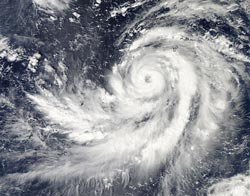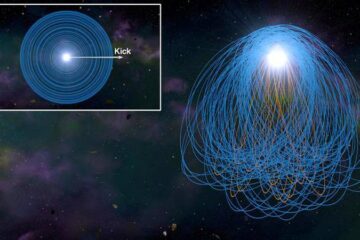NASA Sees Typhoon Francisco Headed to the Other Side of Guam

NASA's Aqua satellite captured this image of Typhoon Francisco on Oct. 17 at 04:05 UTC in the Pacific Ocean as it started turning to the northwest after passing Guam. <br>Image Credit: NASA Goddard MODIS Rapid Response Team <br>
The Moderate Resolution Imaging Spectroradiometer instrument aboard NASA's Aqua satellite captured an image of Typhoon Francisco on Oct. 17 at 04:05 UTC in the Pacific Ocean as it started turning to the northwest after passing the eastern side Guam. The MODIS image clearly showed Francisco's eye, indicating its strength and organization.
On Oct. 17 at 1500 UTC/11 a.m. EDT Francisco had maximum sustained winds near 85 knots and was moving to the north-northeast, but is expected to take a turn to the northwest. Francisco's center was located about 147 nautical miles southwest of Guam, near 12.5 north and 143.1 east.
On Oct. 17 and 18 (local time), a Tropical Storm Warning was in effect for Guam. The National Weather Service bulletin on Oct. 17 at 3 p.m. EDT noted: as Typhoon Francisco (26w) passes…sustained tropical storm force winds are expected. Maximum winds are still forecast to be in the 30 to 40 mph range with gusts to 60 mph. Minor damage may occur to poorly constructed homes. Isolated power outages will be possible. Choppy seas of 12 to 14 feet will persist through tonight.
Text credit: Rob Gutro
NASA's Goddard Space Flight Center
Media Contact
All latest news from the category: Earth Sciences
Earth Sciences (also referred to as Geosciences), which deals with basic issues surrounding our planet, plays a vital role in the area of energy and raw materials supply.
Earth Sciences comprises subjects such as geology, geography, geological informatics, paleontology, mineralogy, petrography, crystallography, geophysics, geodesy, glaciology, cartography, photogrammetry, meteorology and seismology, early-warning systems, earthquake research and polar research.
Newest articles

Stony coral tissue loss disease
… is shifting the ecological balance of Caribbean reefs. The outbreak of a deadly disease called stony coral tissue loss disease is destroying susceptible species of coral in the Caribbean…

Hungry, hungry white dwarfs
… solving the puzzle of stellar metal pollution. Dead stars known as white dwarfs, have a mass like the Sun while being similar in size to Earth. They are common…

Web platform and app aim to improve quality of life for people with Parkinson’s disease
Parkinson’s disease is one of the most prevalent neurodegenerative conditions. It causes motor impairments such as tremors, slow movement, muscle stiffness, and balance problems. The individual course of the disease…





















